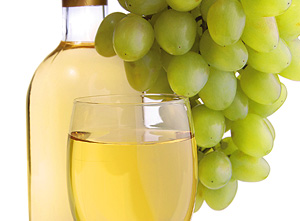 Learning how to make white wine is easy, particularly if you’ve already been making red wines.
Learning how to make white wine is easy, particularly if you’ve already been making red wines.
The main difference is the grape variety being used. You’ll obviously be using a white grape instead of a red grape, otherwise the best you could hope for would be a blush wine.
But beyond this distinction there is another intricacy that has to do with how you will need to process these white grapes.
When making a red wine the grapes are put through a grape crusher and left in the juice (also called must) during the first few days of fermentation. On around the fifth or sixth day the skins and pulp is taken out of the must and then pressed to extract the juice, and then it is discarded.
When making a white wine the grapes are put through the grape crusher and then pressed before the fermentation even starts. Only the white grape juice is in the fermentation. The pulp and skins never see the fermentation. They are put through a wine press and discarded up front.
You may want to take a look at the article Wine Making With Grapes that is on our website. It goes over in better detail the process of making wine from grapes.
———————————————————————————————————
Ed Kraus is a 3rd generation home brewer/winemaker and has been an owner of E. C. Kraus since 1999. He has been helping individuals make better wine and beer for over 25 years.
Category Archives: Wine
How Do I Know When My Steam Juicer Is Done Extracting Juice?
When using a steam juicer to extract the juice from grapes, how do you know when it’s done? In other words, how can you tell when the juicer has done all it can do?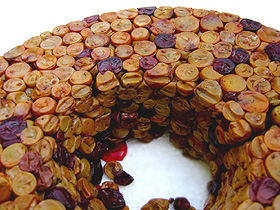
This is the question that was posed to us earlier today by one of our customers in Urbana, Illinois. They are going to make to make some homemade grape wine from Catawbas this year. What a great question!
The steam juicer we offer has a see-through lid. The reason for this is so you can see the condition of the fruit as it is being steam. Through this visual inspection you can tell if the fruit has any more to give or if it has been spent.
In the case of using the steam juicer for processing grapes, you will be able to see that what were once plump grapes are now slowly becoming smaller, shriveled grapes. Eventually, all the grapes will pack to the bottom and form a flat layer of skins. This layer will only be two or three inches high depending on the volume of your steam juicer.
The story is similar for other kinds of fruits as will when using a steam juicer. They will slowly lose their size and compact together at the bottom. Once this occurs, any further steaming is just a waste of time.
———————————————————————————————————
Ed Kraus is a 3rd generation home brewer/winemaker and has been an owner of E. C. Kraus since 1999. He has been helping individuals make better wine and beer for over 25 years.
Experience Heron Bay Homemade Wine Kits.
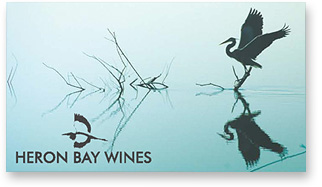 Been thinking about getting some wine brewing? Well, here’s a good reason why you should get started, now. It’s called Heron Bay!
Been thinking about getting some wine brewing? Well, here’s a good reason why you should get started, now. It’s called Heron Bay!
E. C. Kraus is now carrying Heron Bay homemade wine kits. Each kit includes all the wine making materials you will need to make a 6 gallon (30 bottle) batch of wine at home. All you need is the wine making equipment. Heron Bay has the rest.
There are 39 different homemade wine kits from which to choose: 24 Premium Kits (8L) and 15 Ultra Premium Kits (16L) . Each one contains the grape juice for making wine, the wine yeast, the clarifiers, and stabilizers. And most importantly, the homemade wine instructions.
Even the first-time home winemaker will have no problems making quality wine with these kits. The directions are clear, concise and to the point. No mumbo-jumbo, just plain English that anyone can understand.
So, what are you waiting for? Visit our website and take a look at the medley of wines you can make all throughout the year.
———————————————————————————————————
Ed Kraus is a 3rd generation home brewer/winemaker and has been an owner of E. C. Kraus since 1999. He has been helping individuals make better wine and beer for over 25 years.
Why Don't You Sell Rubber Stoppers And Air Locks Together?
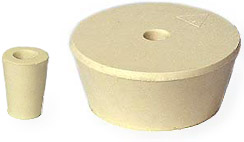 We are often asked why we don’t sell a rubber stopper along together with our air locks, bundled together so to speak. I mean what good is an air lock without the rubber stopper to fit it to something? Well, the answer is really pretty simple.
We are often asked why we don’t sell a rubber stopper along together with our air locks, bundled together so to speak. I mean what good is an air lock without the rubber stopper to fit it to something? Well, the answer is really pretty simple.
Rubber stoppers come in all different diameters–from the size of a dime on up to the size of a orange. The size of rubber stopper you need depends on the what you are trying to attach the air-lock to. For this reason alone we will never be able to sell a rubber stopper and air lock together.
Glass wine carboys have a different sized opening than a gallon glass jugs for example. One takes a size #7 rubber stopper while the other one takes a #8. If you’re using a plastic fermenter you may only need a size #2 rubber stopper. It just depends on the size of the opening.
You may want to take a look at another blog post that covers what rubber stopper fits what. You can also visit our website for more information about the rubber stoppers we have to offer.
———————————————————————————————————
Ed Kraus is a 3rd generation home brewer/winemaker and has been an owner of E. C. Kraus since 1999. He has been helping individuals make better wine and beer for over 25 years.
First Steps In Winemaking, A Timeless Book For Today
 I was fiddling through a bookshelf here at the office the other day when a stumbled across a copy of the book, First Steps In Winemaking. We’ve been selling this book since the ’60’s, but I haven’t really opened it and looked through it for quite some time.
I was fiddling through a bookshelf here at the office the other day when a stumbled across a copy of the book, First Steps In Winemaking. We’ve been selling this book since the ’60’s, but I haven’t really opened it and looked through it for quite some time.
What hit me as somewhat extraordinary was how relevant this book still is today. This wine making book is either a testament to how little the craft has changed over the last 4 decades or how forward-thinking the author, C.J.J. Berry, was when writing this book.
Compared to other wine making books, this one has a lot of great wine making tips that still apply today: like how to prevent your wines from being cloudy, or how to accurately read a gravity hydrometer. These are all issues that are sill being dealt with today by beginning home winemakers.
The other great thing about this book are the recipes. If I remember correctly there are well over a hundred of them–everything from apricot to apple wine is covered. It’s really a treasure-trove of information for someone just starting out.
It has the wine recipes broken down by the month it is best to make them. The idea being you can make wine all throughout the year, winter and summer, if you plan things right.
If you’re new to wine making or not even sure if you want to make wine, I would strongly urge you to at least get First Steps In Winemaking. It will give you a great overview of the home wine making process and let you see what all is involved in this rewarding past time.
———————————————————————————————————
Ed Kraus is a 3rd generation home brewer/winemaker and has been an owner of E. C. Kraus since 1999. He has been helping individuals make better wine and beer for over 25 years.
Prepare Your Grapes Just Right With A Grape Crusher
When you’re making wine from grapes one of the major tasks at hand is getting all those grapes crushed up. You can do it all by hand, or you can do it the easy way and get a grape crusher.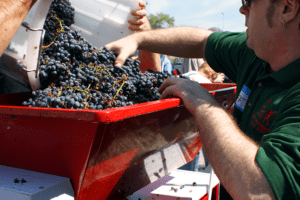
A good grape crusher will only burst the grapes and not mangle or shred the skins. Grape skins that are over processed will release excessive, bitter tannins (tannic acid) into the wine during primary fermentation and pressing. And, that’s a bad thing.
It’s important that the grapes be crushed correctly. You need a crusher that will do it just right.
With pretty much any grape crusher the grapes go into a hopper and fall in between two turning rollers. The trick is to have the two rollers separated at just the right distance to burst the grape–no more no less.
Our Stainless Steel Fruit Crusher has adjustable rollers that will allow you to set the distance to whatever it needs to be. Whether you’re crushing huge Scuppernong grapes or teeny, tiny Cabernet grapes this crusher can handle it to perfection.
As an added feature the Stainless Steel Fruit Crusher can also handle other fruits as well: raspberries, strawberries, blackberries, cherries. And, because it also has rotating knives within the hopper, it can chop-up and crush apples, pears and other orchard fruit with very little effort. As far as homemade wine equipment goes, this one will save you a lot of work.
———————————————————————————————————
Ed Kraus is a 3rd generation home brewer/winemaker and has been an owner of E. C. Kraus since 1999. He has been helping individuals make better wine and beer for over 25 years.
A Tip On Using A Steam Juicer For Making Wine.
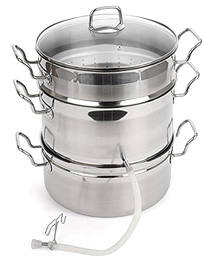 Here’s a great tip from one or our customers, Dave in Anacoco, Louisiana.
Here’s a great tip from one or our customers, Dave in Anacoco, Louisiana.
He uses a steam juicer as a way to get as much juice out of the fruit as possible. He also uses it as as a way to gather together the pulp for the fermentation.
Dave makes homemade grape wine from scuppernong grapes he grows himself. He says he puts the grapes in his steam juicer to extract the juice. Once the juice as been collected, he takes the pulp and puts it in a fermentation bag and hangs it directly in the fermentation.
This is a great idea, Dave! Using the steam juicer in this way allows you to get every drop of juice extracted from the grapes. Putting the pulp in with the fermentation allows you to get all the well-rounded flavors from the grape’s skin and pulp as well.
Using this method is also a great way to separate the pulp from the juice so that you can keep it collected in a fermentation bag. That way you don’t have to worry about getting all the pulp out of the way later, after the primary fermentation has completed.
———————————————————————————————————
Ed Kraus is a 3rd generation home brewer/winemaker and has been an owner of E. C. Kraus since 1999. He has been helping individuals make better wine and beer for over 25 years.
E. C. Kraus Is Now Offering Heron Bay Grape Juices!
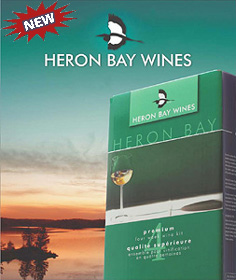 Exciting news! We now have available Heron Bay homemade wine kits!
Exciting news! We now have available Heron Bay homemade wine kits!
We have added Heron Bay grape concentrates to our–already extensive–list of wine ingredient kits. Heron Bay is a leading provider of grape juice for wine making. Their products have been providing home winemakers like yourself with excellent homemade grape wine for many, many years.
There are 39 different varieties to choose from spread across two different Heron Bay lines: their Premium 8 liter kits and their Ultra Premium 16 liter kits.
Each of these homemade wine kits will make 6 gallons (30 bottles) of wine. They include the grape juice for wine making along with all the additional ingredients you will need such as yeast, clarifiers, stabilizers, etc.
Each of these homemade wine kits also come with detailed instructions that lead you through the entire wine making process. They show you how to make your own wine.
We are expecting the arrival of our first shipment either today or tomorrow, however you can go ahead and place your order right now on our website or by phone (800) 353-1906. We will ship your Heron Bay kits once the product arrives in our warehouse.
Also remember that you will always receive Free Shipping on these products, and when you order two or more wine making juices, regardless of the brand, you will also receive a 10% discount on all of them.
———————————————————————————————————
Ed Kraus is a 3rd generation home brewer/winemaker and has been an owner of E. C. Kraus since 1999. He has been helping individuals make better wine and beer for over 25 years.
Using Glass Gallon Jugs When Bottling Homemade Wine
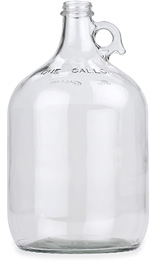 When it comes to bottling homemade wine, we often get questions about using gallon glass jugs in place of the standard 750ml wine bottle. Some winemakers like the idea of using jugs simply because it is less work. If you have 5 or 6 gallons of wine, just put it in 5 or 6 one gallon jugs and be done with it.
When it comes to bottling homemade wine, we often get questions about using gallon glass jugs in place of the standard 750ml wine bottle. Some winemakers like the idea of using jugs simply because it is less work. If you have 5 or 6 gallons of wine, just put it in 5 or 6 one gallon jugs and be done with it.
I can tell you that bottling homemade wine in gallon jugs is perfectly okay. The wine will keep just as good as if it were in wine bottles. Not an issue at all.
Where the problem can rise is when it comes time to decant the wine. Having leftover partial containers of wine whether it be in glass jugs or wine bottles is not a good thing. The size of the container needs to be appropriate to the amount of consumption unless you have a wine preservation system of some sort.
Air is a big enemy to a still wine. Over time air will allow the wine to oxidize and eventually spoil. We’ve all put a half bottle of wine in the refrigerator and been perfectly happy with it later on, but this habit can only be taken so far. If done again and again with the same gallon an overall degradation of the wine will begin to be noticeable.
Long story short, using gallon jugs is perfectly fine for bottling your wine, however you should only do so if you plan on drinking that gallon in two or three days or if you have a wine preservation system. Having air in with the wine for longer than this will only be a negative for the wine not a plus.
———————————————————————————————————
Ed Kraus is a 3rd generation home brewer/winemaker and has been an owner of E. C. Kraus since 1999. He has been helping individuals make better wine and beer for over 25 years.
Surprise Family And Friends With A Personalized Wine Gift
 Imagine walking into your next dinner party with a bottle of wine–you personally made–in your hands. Whether it be Super Bowl Sunday, Forth of July, or just a Friday night with friends, a bottle of homemade wine makes a wonderful personalized wine gift that fits any occasion.
Imagine walking into your next dinner party with a bottle of wine–you personally made–in your hands. Whether it be Super Bowl Sunday, Forth of July, or just a Friday night with friends, a bottle of homemade wine makes a wonderful personalized wine gift that fits any occasion.
You can have fun customizing the wine bottle labels for different events: Poker Pinot, Barbecue Burgundy, Chris & Amber’s Wedding shower–Congratulations! They also make wonderful wine making gifts during the holiday season: Merry Christmas–Uncle Don.
 We offer a variety of wine bottle labels that you can customize on your computer into surprising, decorative wine making gifts. We have six designs from which to choose. They come four wine bottle labels on a standard 8-1/2″ by 11″ sheet, so they’ll easily feed through any computer printer.
We offer a variety of wine bottle labels that you can customize on your computer into surprising, decorative wine making gifts. We have six designs from which to choose. They come four wine bottle labels on a standard 8-1/2″ by 11″ sheet, so they’ll easily feed through any computer printer.
To get started putting together your personalized wine gifts all you have to do is get your imagination going. What’s the next event on your calendar? Who’s birthday is coming up? Now’s the time to get those wine bottle labels ready!
———————————————————————————————————
Ed Kraus is a 3rd generation home brewer/winemaker and has been an owner of E. C. Kraus since 1999. He has been helping individuals make better wine and beer for over 25 years.
